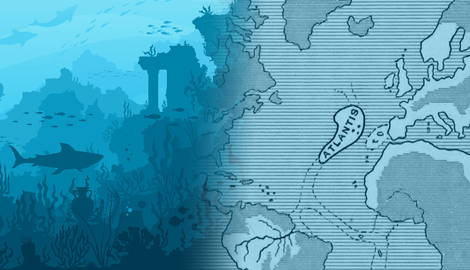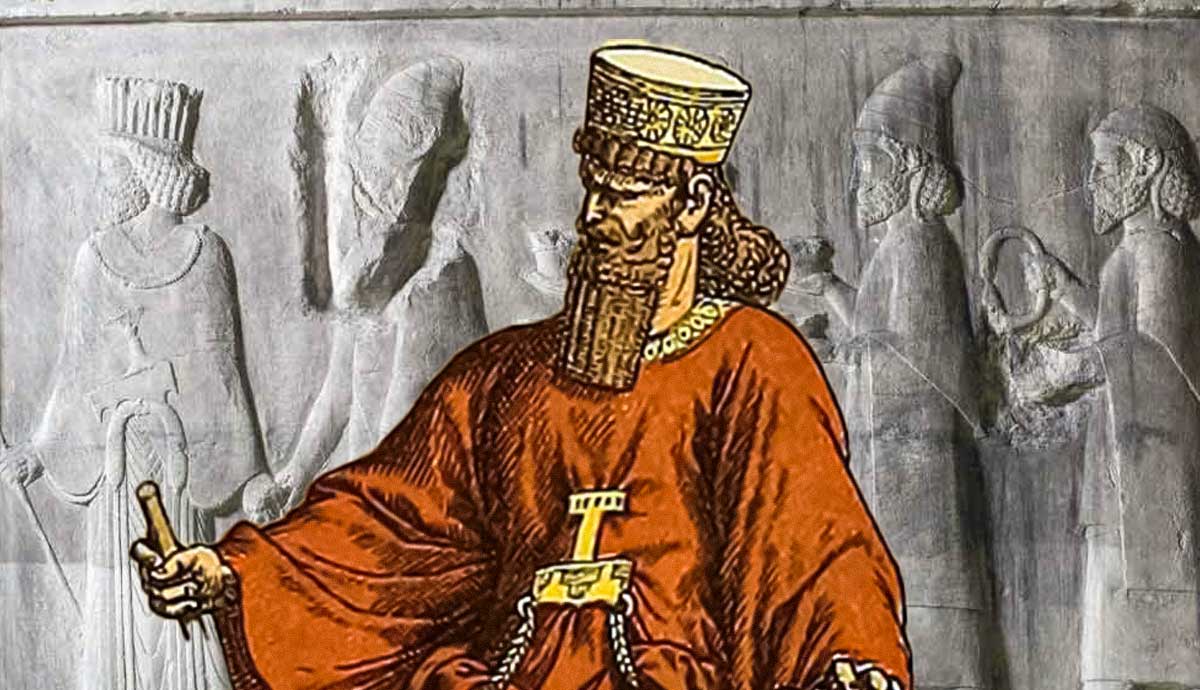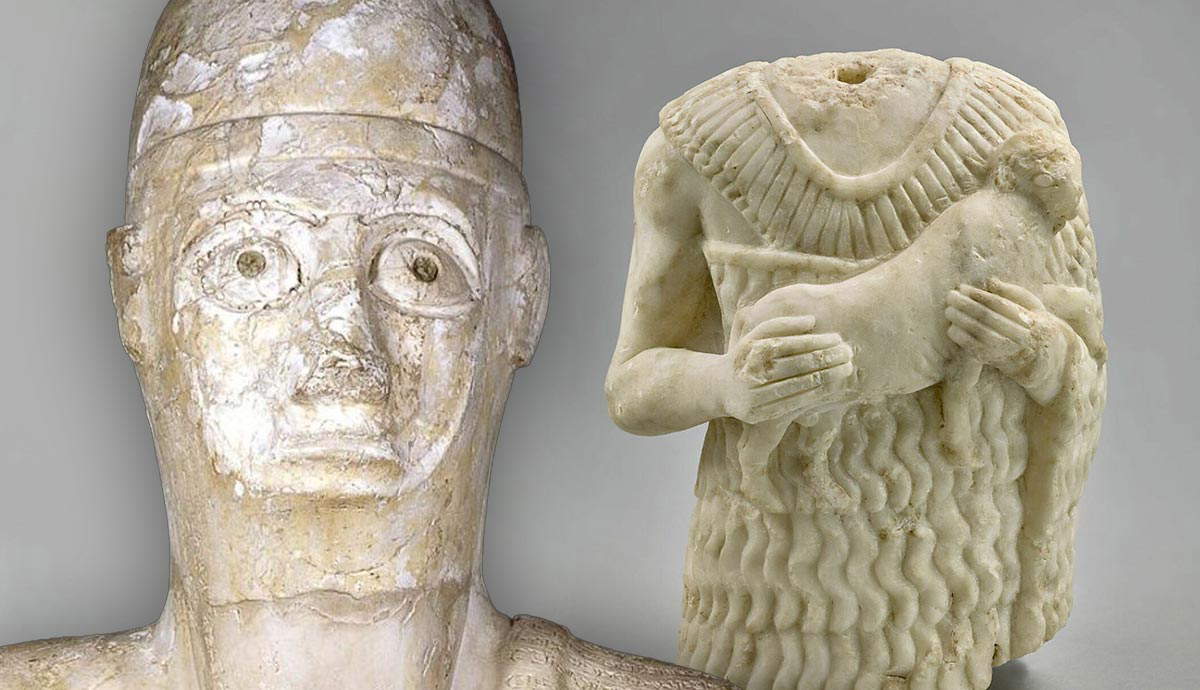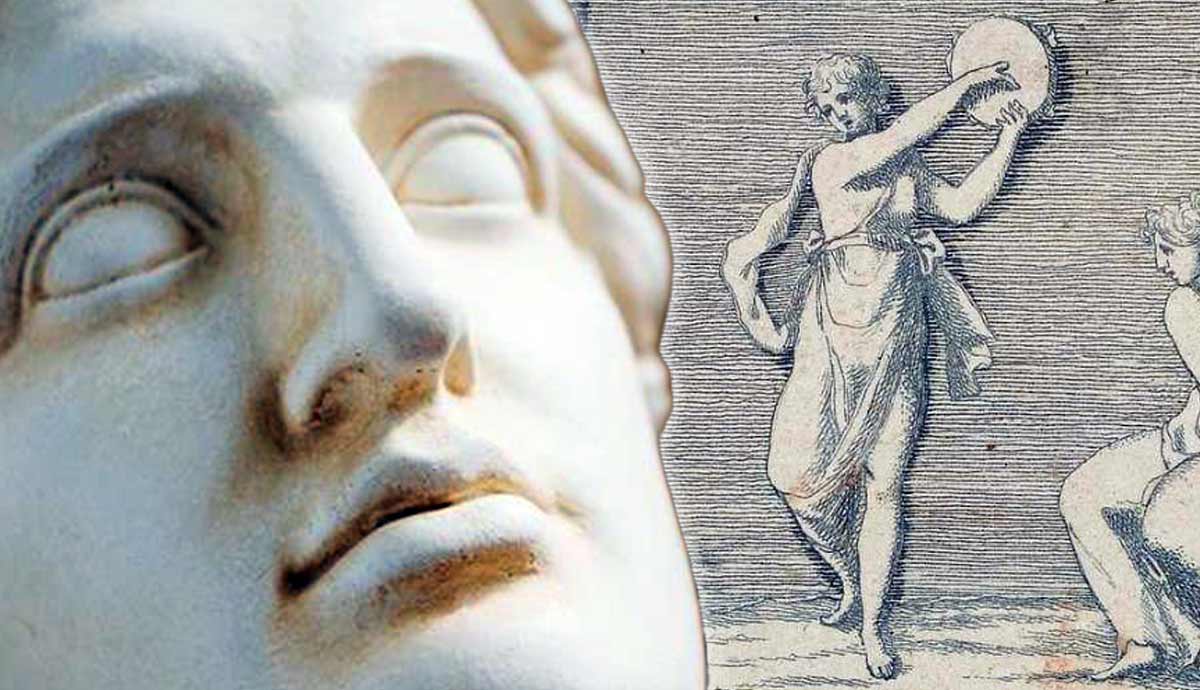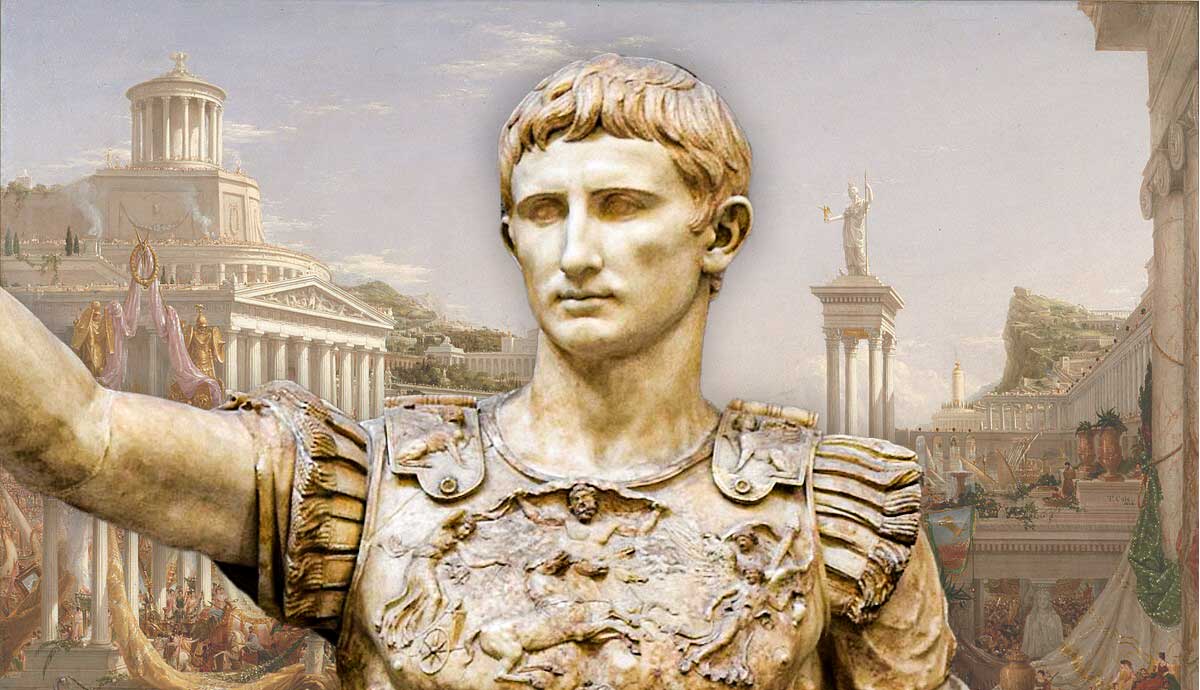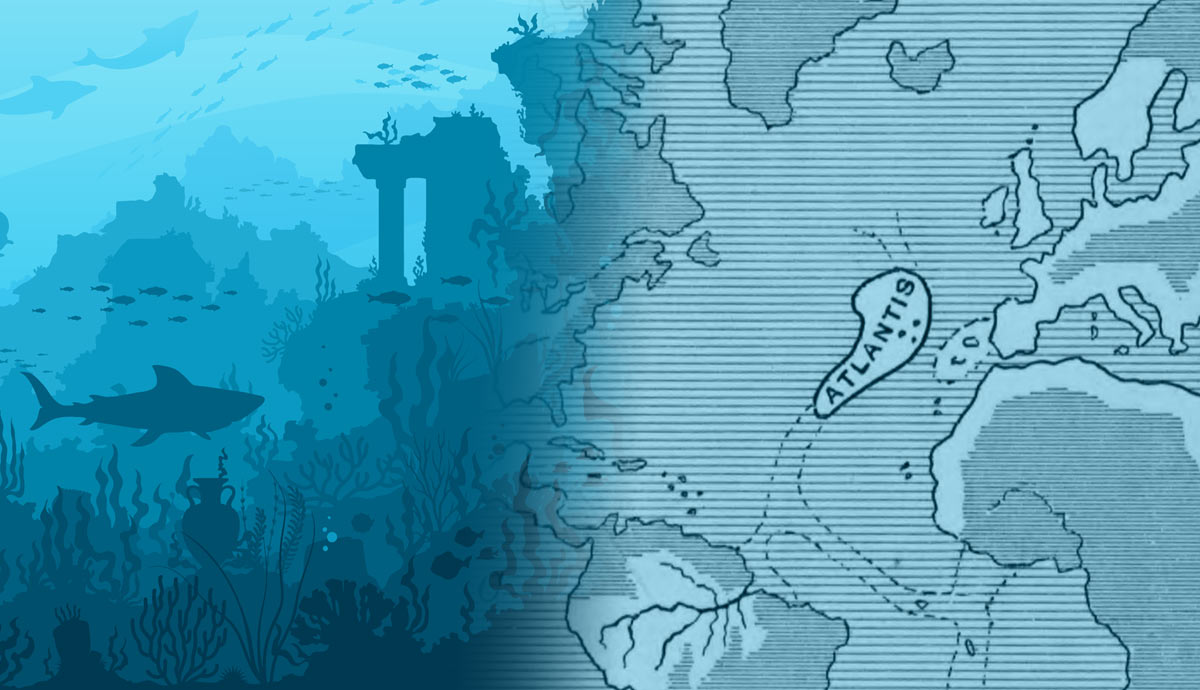
The rumor of Atlantis can be traced back to the Greek philosopher Plato, who wrote about the island kingdom in two of his dialogues: Timaeus and Critias. Historiographical examination of these sources has led to three primary theories about Atlantis. First, it was a real place located somewhere in the eastern Mediterranean. Second, Plato invented an ideal city as a vehicle to warn against a corrupt and degenerate state. Third, Atlantis was a compilation of various ancient traditions used as topoi to illustrate themes of good versus evil.
Atlantis According to Plato

The Athenian philosopher, Plato (c. 428-348 BCE), wrote Timaeus and Critias in the dialogue style for which he became known. Timaeus is the longer of the two, covering a range of topics, while the shorter Critias primarily focuses on Atlantis. When taken together, they present an interesting narrative of Atlantis that Plato claimed was the “complete truth.”
According to Plato, the Athenian statesman and lawgiver Solon (c. 630-560 BCE) learned of Atlantis when he traveled to Egypt. Solon met with the priest of Neith (whom the Greeks equated with Athena) in the city of Sais, the capital city of Egypt at the time. One particular priest lectured Solon on the youngness of Greek culture, and how the Egyptians had better records about ancient events.
“Solon, Solon, you Greeks are ever children; there is no such thing as an old Greek.” “What do you mean by that?” inquired Solon. “You are all young in mind,” came the reply: “you have in your minds no belief rooted in old tradition and no knowledge hoary with age. And the reason is this. There have been and will be many different calamities to destroy mankind, the greatest of them by fire and water, lesser ones by countless other causes.”

The priest then explained to Solon how the Egyptian sacred texts list the pharaonic state as 8,000 years old while Atlantis was 9,000 years old. The claim was an establishment of authority, which further supported Plato’s assertion that the story was true. The priest continued, telling Solon the following:
“Our records tell how your city checked a great power which arrogantly advanced from its base in the Atlantic ocean to attack the cities of Europe and Asia. For in those days the Atlantic was navigable. There was an island opposite the strait which you call (so you say) the Pillars of Hercules, an island larger than Libya and Asia combined.”
The use of the term “your city” is important because it makes the text less objective and places Plato on the side of primeval Athens against Atlantis. Plato then related how Atlantis was destroyed.
“Earthquakes and floods of extraordinary violence, and in a single dreadful day and night all your fighting men were swallowed up by the earth, and the island of Atlantis was swallowed up by the sea and vanished.”

Many important details of the Atlantis story are missing from the Timaeus account, particularly the reasons for the destruction. But also missing from the account are descriptions of the city’s history and its physical attributes. For that, one must turn to Critias.
Atlantis in Critias

The much more detailed account of Atlantis in Critias begins by describing how Atlantis was settled by Poseidon and the offspring he had with the mortal woman Cleito. Much of the account provides an in-depth physical description of Atlantis. Part of the description reads:
“They began by digging a canal three hundred feet wide, a hundred feet deep and fifty stades long from the sea to the outermost ring, thus making it accessible from the sea like a harbour; and they made the entrance to it large enough to admit the largest ships. At the bridges they made channels through the rings of land which separated those of water, large enough to admit the passage of a single trireme, and roofed over to make an underground tunnel.”
The account also describes how the acropolis was in the middle of the city, surrounded by a ring of water. On the acropolis was the palace, a shrine to Poseidon, and springs. There were gardens, a stadium, and gymnasia in the lower part of the city.

Other notable elements of Atlantis that Plato described in Critias include the political structure. The island was ruled by ten kings with an additional paramount king. Plato also stressed how Atlantis was materially rich in timber and orichalc, which is believed to have been copper and/or bronze. Although Atlantis’s layout was certainly unique according to Plato, it was by no means exotic compared to classical or even Late Bronze Age cities. The idea of flying cars and other Atlantean esoteric technologies is absent from Plato’s accounts. These concepts were introduced in modern times by pseudohistorians, followers of the occult, and science fiction writers.
Another notable difference between Timaeus and Critias, is that the latter related the reasons why Atlantis fell. According to Plato, Atlantis was punished by Zeus because the Atlanteans were unable to “carry their prosperity with moderation.” With the details of Plato’s accounts of Atlantis in mind, an examination of modern historiographical studies of the legendary state is warranted.
Atlantis as a Physical Location

Scholarly interest in assigning a physical location to Atlantis is fairly recent. Throughout history, there have been many pseudohistorical ideas about Atlantis that have filtered into both academia and the mainstream. The most common scholarly theory of Atlantis’s location places it in the eastern Mediterranean Sea, with it being swallowed up by volcanoes during the Bronze Age. Seismologists A. G. Galanopoulos and E. Bacon first proposed the idea that Atlantis was located on the island of Thera (modern Santorini) in their 1969 book, Atlantis: The Truth Behind the Legend. The men argued that life on the island was destroyed in about 1500 BCE, with the eruption probably measuring seven on the volcanic explosivity index (VEI). Neither Galanopoulos nor Bacon were archaeologists or classical historians, so their theory did not immediately make major headway in academia.
Around the same time as Galanopoulos and Bacon published their work, Greek archaeologist Spryidon Marinatos published his reports of the excavations he did at Thera. Although Marinatos agreed with Galanopoulos and Bacon that Atlantis was an actual city of the Minoan culture (c. 3100-1400 BCE), he placed the city on the island of Crete. Crete was, after all, the primary island of the Minoan culture, so if Atlantis was as grand as Plato claimed it was, then it must have been on Crete. Identifying the city itself proved to be problematic.

In addition to not being able to identify where Atlantis was on Crete, there are other problems with the Crete-Thera hypotheses. First, Plato clearly placed Atlantis in the Atlantic Ocean, beyond the Pillars of Hercules. Second, according to Plato, Atlantis was much older than Crete. It should be noted that the Minoan culture was already ancient in Plato’s lifetime. The palaces of Knossos and the other cities of Crete were destroyed during the Bronze Age collapse after 1200 BCE. The result of the destruction was that the classical Greeks knew little to nothing about Minoan culture. Also, the Myceneans had conquered Create about 1400 BCE, placing a proto-Greek cultural veneer over the island.
Early Ideas About the Location of Atlantis

Marinatos’ ideas spawned several followers and similar theories in the following decades, but numerous early writers also pondered the physical location of Atlantis. Interestingly, classical historians had little to say about Atlantis. The 1st-century BCE/CE Greek geographer and historian Strabo cites the 1st-century BCE Greek philosopher Poseidonius, who himself cited Plato’s account of Atlantis. Strabo wrote that “it is possible that the story about the island of Atlantis is not a fiction.” This is hardly a ringing endorsement of Atlantis and the geographer offers no theory of its location.
Church scholars revived interest in Atlantis in late antiquity and the Middle Ages. The early Church scholars were less interested in physically locating Atlantis than in connecting it to the Bible. For Clement of Alexandria and Eusebius of Caesarea, Plato became a student of Moses. The Church historians argued that Plato really received his arcane knowledge from the Near East as a student of Moses and that evidence of Atlantis could be found in the Bible.

The Enlightenment witnessed new interpretations of Atlantis that were based on the emerging rational philosophies of the time as well as the discovery of the Americas. In 1841, French scholar Thomas-Henri Martin published Études sur le Timée de Platon, which surveyed the historiography of Atlantis. Martin noted that it was popular at the time for many people to identify the Americas as Atlantis, but that he believed the island belonged “to another world.” After Martin, scholarly studies of Atlantis waned in favor of pseudo-histories and occult theories, such as theosophy.
Atlantis as a Vehicle for Greek Philosophy

Today, most classical scholars believe that Atlantis was not real, with many arguing that it was a topos used as a didactic tool. Although Plato was not a historian, his philosophy of history was one of cyclical degeneration. Ultimately, the story of Atlantis was a comparison of a virtuous city-state and a degenerate state, similar to Plato’s Republic. Timaeus and Critias were also written in dialogue format, like the Republic, with Plato’s teacher Socrates playing a major role in the discussion.
Naddaf argued that following Greek thought, Atlantis was maritime and unstable while Athens was terrestrial and stable. The instability and maritime background of Atlantis was “otherness” and therefore evil in Plato’s dualistic view of the world. But Vidal-Naquet added that really these were the two faces of Athens in Plato’s life. The primordial Athens of the Atlantis tale was the ideal that Plato and many of his contemporaries praised—it was the Athens of Themistocles. On the other hand, Atlantis was the Athens of Pericles. The first was a Greek city-state that supported its fellow Greeks against a foreign horde while the second was a corrupt imperial power.
Non-Greek Influences on the Atlantis Tradition

The final sources to consider for the Atlantis myth are of non-Greek origins. Because Plato claimed that Solon first learned of the legend from Egyptian priests, a closer look at Plato’s work in the context of Egyptian culture is needed. Egyptologist J. Griffiths documented several similarities in Plato’s description of Atlantis with elements from ancient Egyptian history. One of the more interesting comparisons he drew was from a Middle Kingdom fictional story known as The Shipwrecked Sailor.
In The Shipwrecked Sailor, an Egyptian mariner is shipwrecked on a magical island that is inhabited by a giant talking serpent. The serpent explained to the sailor that he was the last of his race and that soon his island would be consumed by the ocean.
“Moreover, when you have left this place, you will not see this island again; it will have become water.”

The magical island that sank into the sea is certainly interesting when compared to Atlantis’ similar fate. But Griffiths pointed out a number of other similarities. He argued that Egypt’s numerous canals, especially in the Delta, could have been an inspiration for the canals of Atlantis. Sais, the city that Solon visited, was in the Delta and canals would have been quite visible to any visitor. Griffiths also believed that the ten subordinate kings and the paramount king who ruled Atlantis were a possible reflection of the Egyptian government. Throughout Egyptian history, the kingdom was divided into nomes, which were administered by nomarchs. The nomarchs were similar to governors but they yielded much more power, depending on the period. Above the nomarchs was the pharaoh, who, like the king of Atlantis, was divine.
Griffiths also noted that other non-Greek sources could have provided at least partial inspiration for the Atlantis myth. Carthage, which was a sea power in the western Mediterranean that warred with the Greeks in 535 BCE, could have provided partial inspiration. It is also possible that the Achaemenid Persians, whom the Greeks viewed as decadent, may have been material for Atlantis’s decline.
Assessing Atlantis

The idea of the lost continent, or city, of Atlantis has intrigued people since Plato first mentioned it in his dialogues Timaeus and Critias. An examination of the historiographical sources demonstrates that attitudes about its historicity have changed with the times and have been influenced by culture and religion. Although some respected scholars have claimed to have identified Atlantis among the ruins of Minoan culture, it is more likely that the continent was a literary tool. Plato probably drew on elements from the culture and history of previous Near Eastern societies to distill his vision of an ideal state. Much like he did in the Republic, Plato then employed traditional Greek philosophy to contrast an ideal society with one that is decadent, degenerate, and foreign.
